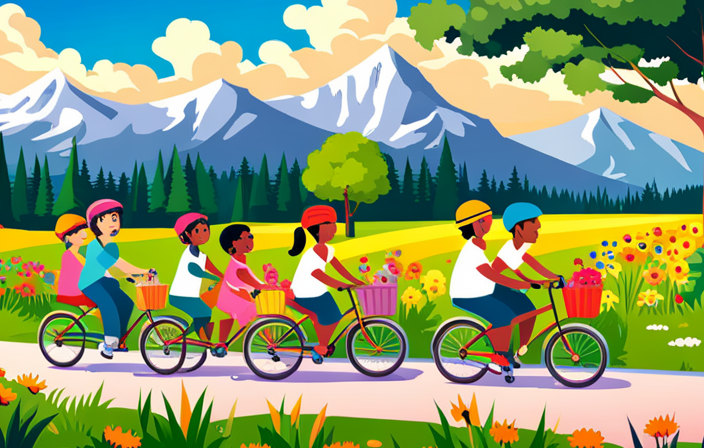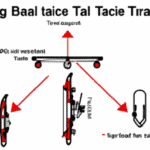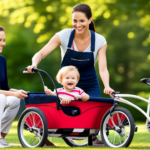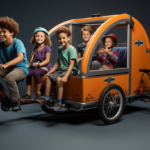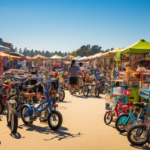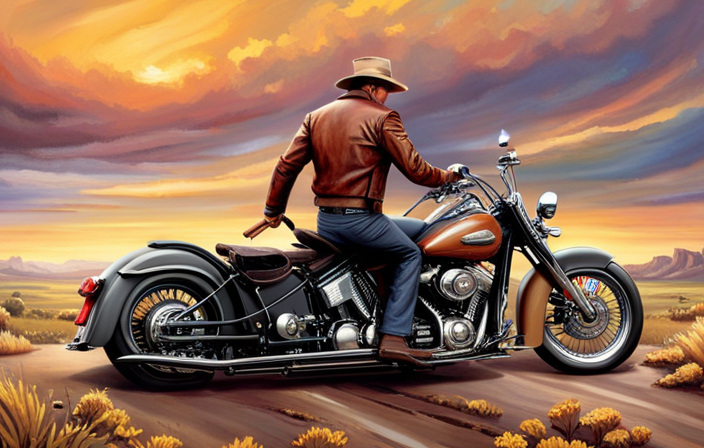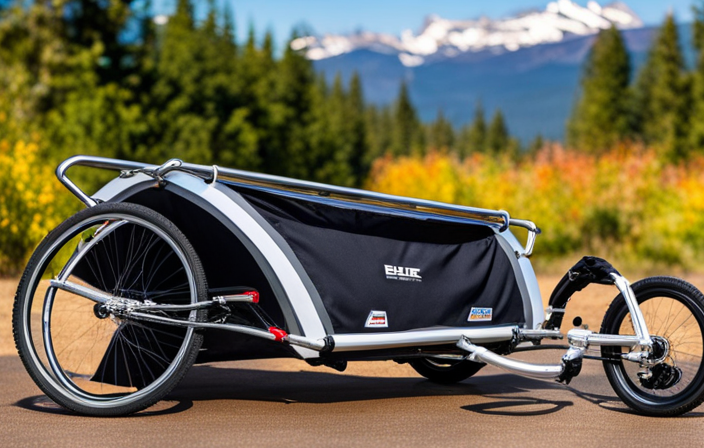Considering taking your little one out on bike trails? You’ve come to the right spot! This article will inform you about the age appropriateness of bike trailers.
From safety considerations to developmental milestones, I’ve got you covered. So, grab your helmet and get ready to pedal your way to a fun and safe adventure with your child.
Let’s dive in!
Key Takeaways
- Bike trailers are generally suitable for children at least 1 year old.
- It is important to ensure proper neck and head control for younger children.
- Consider the weight limit of the trailer and check the manufacturer’s instructions for attachment.
- Individual development, milestones, and readiness should also be taken into account.
Safety Considerations for Bike Trailers
When using a bike trailer, it’s important to ensure that all safety considerations are taken into account. This includes using proper harnesses and reflective gear. Bike trailers are a great way to transport young children, but it’s crucial to follow the recommended age range for their safety. Generally, bike trailers are suitable for children between the ages of 1 and 6 years old. Younger children should have proper neck and head control before using a bike trailer.
Additionally, it’s important to be aware of common safety hazards associated with bike trailers. These can include uneven terrain, sharp turns, and sudden stops. To prevent accidents, it’s essential to ride cautiously and avoid risky maneuvers. Always make sure the trailer is securely attached to the bike and that the child is properly harnessed and secured within the trailer. Reflective gear is also crucial to make the trailer visible to other road users, especially during low-light conditions.
Understanding and adhering to these safety considerations will help ensure a safe and enjoyable experience when using a bike trailer.
Now, let’s move on to understanding the weight and size limits of bike trailers.
Understanding the Weight and Size Limits
To determine if a bike trailer is right for you, consider the weight and size limits. Understanding the weight limits is crucial for ensuring the safety and stability of the trailer while in use. Here are some key points to keep in mind:
- Maximum weight capacity: Bike trailers come with a specified weight limit that indicates the maximum weight it can safely carry. Make sure to check this limit before purchasing a trailer to ensure it can accommodate your needs.
- Payload weight: In addition to the weight of your child, consider any additional items you plan to carry in the trailer, such as snacks, toys, or diaper bags. Remember to factor in the combined weight to stay within the trailer’s limit.
Choosing the right size of the bike trailer is equally important for a comfortable and enjoyable ride. Consider the following:
- Interior space: Ensure that the trailer provides enough room for your child to sit or lie comfortably. Take into account their height, width, and legroom requirements.
- Folded dimensions: If storage space is a concern, check the folded dimensions of the trailer to ensure it can fit into your available space easily.
Understanding the weight and size limits of a bike trailer is vital in selecting the right one for your needs. By considering these factors, you can ensure a safe and enjoyable experience for both you and your child.
Now let’s explore the recommended age range for bike trailers.
Recommended Age Range for Bike Trailers
The recommended age range for using bike trailers is typically based on the child’s development and readiness. It is important to ensure that your child is physically and mentally ready to ride in a bike trailer. One key factor to consider is the weight limit of the trailer. Most bike trailers have a weight limit of around 75 to 100 pounds, depending on the specific model. This means that the child should not exceed this weight in order to ensure safety and proper functioning of the trailer.
Another important consideration is the attachment options for the bike trailer. Bike trailers can be attached to the rear axle of the bike or to a bike rack. Some trailers also have the option of converting into a stroller or jogger, providing added versatility for parents. It is crucial to carefully follow the manufacturer’s instructions for proper attachment and use.
With these factors in mind, it is generally recommended that children be at least 1 year old before riding in a bike trailer. At this age, they have typically developed enough neck and head control to safely ride in the trailer. However, it is important to remember that every child is different, and their individual development should be taken into consideration. As children grow and develop, they will reach important milestones that indicate their readiness for riding in a bike trailer.
Developmental Milestones for Riding in a Bike Trailer
You should assess your child’s developmental milestones to determine if they’re ready to ride in a bike trailer. It’s important to consider their physical and cognitive abilities before introducing bike trailer accessories and reaping the benefits of riding in a bike trailer.
One of the key milestones to look for is their ability to sit up and support their own head. This is crucial for their safety and comfort during the ride. Additionally, your child should have good neck and trunk control, as well as the ability to balance themselves while sitting. These skills will ensure a stable and enjoyable ride for both you and your child.
Another important milestone to consider is their ability to follow simple instructions and understand basic safety rules. This is essential for their safety and for you to have peace of mind while riding together. It’s also important to assess their temperament and behavior, as some children may not feel comfortable or enjoy being in a bike trailer.
Ensuring proper helmet fit for your child is the next step in ensuring their safety while riding in a bike trailer.
Ensuring Proper Helmet Fit for Your Child
It’s crucial to ensure that your child’s helmet fits properly for their safety while riding in a bike trailer. Proper helmet sizing is essential in protecting your child’s head from potential injuries. A helmet that is too loose may not provide adequate protection, while a helmet that is too tight can cause discomfort and restrict circulation.
To determine the correct helmet size for your child, measure their head circumference and choose a helmet that corresponds to the measurement. It’s important to note that different helmet brands may have varying size charts, so always refer to the manufacturer’s guidelines.
When fitting the helmet, make sure it sits level on your child’s head, covering their forehead without obstructing their vision. The straps should form a V-shape under the ears and be snugly fastened. Additionally, check for any gaps between the helmet and your child’s head, as these can indicate an improper fit.
By ensuring the proper helmet fit, you can provide your child with the necessary protection while they enjoy their bike trailer adventures.
Now that you know the importance of proper helmet fit, let’s discuss introducing your child to the bike trailer.
Introducing Your Child to the Bike Trailer
Now that you’ve familiarized yourself with proper helmet fit, let’s talk about how to introduce your child to the bike trailer. Bike trailers are a great way to get your child involved in outdoor activities while ensuring their safety. Not only do they provide a comfortable and secure space for your child, but they also allow you to enjoy your bike rides without worrying about their wellbeing.
To make the transition to the bike trailer smooth and enjoyable for your child, it is important to introduce them to it in a positive and engaging manner. Start by showing them the trailer and explaining its purpose. Let them explore it and get familiar with the space. You can also consider adding some bike trailer accessories like toys or cushions to make it more inviting.
Here is a table highlighting the benefits of bike trailers for children:
| Benefits of Bike Trailers for Children |
|---|
| 1. Safety and protection |
| 2. Comfort and support |
| 3. Interaction and bonding |
| 4. Exposure to the outdoors |
| 5. Physical and cognitive development |
The Importance of Properly Securing Your Child in the Trailer
To ensure your child’s safety while riding in the trailer, make sure they are properly secured with the harness and straps. Properly securing your child is of utmost importance when it comes to using a bike trailer. These safety precautions are crucial in order to prevent any accidents or injuries.
The harness and straps are designed to keep your child in place and provide support while you ride. They should be snug, but not too tight, allowing your child to move comfortably while still being securely fastened. It is important to double-check the harness and straps before every ride to ensure they are properly adjusted and fastened. This will give you peace of mind knowing that your child is safe and secure throughout the entire journey.
Now that you understand the importance of properly securing your child in the trailer, let’s discuss the next step: choosing the right type of bike trailer for your child.
Choosing the Right Type of Bike Trailer for Your Child
When selecting a bike trailer for your child, consider their size and weight to ensure a proper fit. Introducing bike trailers to older children can be a great way to enjoy family outings and explore the outdoors together.
Here are some benefits of using a bike trailer for these outings:
-
Safety: Bike trailers provide a secure and enclosed space for your child, protecting them from potential hazards on the road.
-
Comfort: Most bike trailers come with padded seats and harnesses, ensuring a comfortable ride for your child.
-
Storage: Bike trailers often have ample storage space, allowing you to bring along snacks, toys, and other essentials for your family outings.
-
Versatility: Some bike trailers can be converted into strollers or joggers, giving you the flexibility to use them in different scenarios.
By using a bike trailer, you can create lasting memories with your child while promoting a healthy and active lifestyle.
Now, let’s move on to some tips for a comfortable and enjoyable ride.
Tips for a Comfortable and Enjoyable Ride
One way to ensure a comfortable and enjoyable ride is by adjusting the seat and harness of the bike trailer to fit your child securely. It’s important to choose a bike trailer that comes with adjustable seats and harnesses so that you can customize the fit to your child’s size and comfort level. This will not only provide a safer ride but also prevent any discomfort or irritation during the journey.
Additionally, there are various bike trailer accessories available in the market that can further enhance your child’s comfort and enjoyment. These accessories include padded seats, sunshades, and even storage compartments for snacks and toys. By investing in the right bike trailer and accessories, you can create a cozy and entertaining environment for your child while riding together.
Transition: Now that you have adjusted the seat and harness of the bike trailer and have chosen the right accessories, it’s important to take certain precautions when riding with a bike trailer to ensure the safety of both you and your child. Without further ado, let’s explore these essential precautions.
Precautions to Take When Riding with a Bike Trailer
As we continue our journey into the world of bike trailers, we now turn our attention to the precautions that should be taken when riding with a bike trailer. It is essential to ensure the safety and comfort of your child throughout the ride.
Before embarking on any adventure, it is crucial to prepare your child for riding in a bike trailer. Start by explaining the rules and expectations for the ride, such as wearing a helmet and staying seated at all times. Encourage them to ask questions and address any concerns they may have.
When it comes to choosing the right bike trailer for your needs, there are a few factors to consider. First, think about the number of children you will be carrying. Some bike trailers are designed for a single child, while others can accommodate two or more. Next, consider the weight and age limits of the trailer. Ensure that it can safely support your child’s weight and that they are within the recommended age range. Additionally, look for trailers with safety features such as a secure harness system and reflective materials for visibility.
By taking these precautions and selecting the appropriate bike trailer, you can provide a safe and enjoyable riding experience for your child.
In the next section, we will explore how to adjust the trailer for your child’s comfort and safety, ensuring a smooth and pleasant journey.
Adjusting the Trailer for Your Child’s Comfort and Safety
To ensure your child’s comfort and safety in the bike trailer, it’s important to properly adjust the trailer for their needs. Here are some key steps to follow:
-
Adjust the straps: Begin by adjusting the straps to ensure a secure fit. The shoulder straps should be snug but not too tight, allowing your child to move comfortably. The waist and chest straps should also be adjusted to prevent any slipping or sliding.
-
Proper seating position: Make sure your child is seated upright with their back against the seat. This will provide them with the necessary support and prevent them from slumping or leaning to one side. Adjust the seat if needed to achieve the proper position.
-
Check helmet fit: Before every ride, check that your child’s helmet fits properly and securely. It should sit level on their head and be snug enough to not move around.
-
Secure any loose items: Before hitting the road, make sure any loose items such as toys or blankets are securely stowed away. These items can become dangerous projectiles if not properly secured.
-
Regularly inspect the trailer: Take the time to inspect the trailer before each ride. Check for any loose or damaged parts, and ensure that the trailer is properly attached to the bike.
By following these steps, you can ensure that your child is comfortable and safe in the bike trailer.
Now, let’s move on to safety tips for riding in different weather conditions.
Safety Tips for Riding in Different Weather Conditions
Make sure you regularly check the weather forecast before heading out on a bike ride. Riding in different weather conditions requires extra caution and preparation to ensure your safety.
When it comes to riding in heavy rain, it is important to have the right gear. Invest in a good quality waterproof jacket and pants to keep yourself dry. Consider wearing a helmet cover to protect your head from the rain. Riding in heavy rain can make the roads slippery, so reduce your speed and increase your braking distance to avoid accidents.
Riding in strong winds can also be challenging. Be aware of the wind direction and adjust your riding position accordingly. Keep a firm grip on the handlebars and use your body to counterbalance the wind. If the winds become too strong, it may be wise to find a sheltered area and wait until the wind subsides before continuing your ride.
Transitioning from a bike trailer to a child bike seat requires careful consideration of the child’s age and readiness to ride independently.
Transitioning from a Bike Trailer to a Child Bike Seat
When transitioning from a bike trailer to a child bike seat, it’s important to consider the child’s readiness and their ability to ride independently. Bike trailers and child bike seats both have their pros and cons, so it’s crucial to weigh the options before making the switch.
One of the main advantages of using a bike trailer is that it provides a safe and comfortable space for your child, with a secure harness system and a protective cover to shield them from the elements. Additionally, bike trailers typically have more storage space, allowing you to carry snacks, toys, and other essentials for your little one. However, bike trailers can be bulkier and harder to maneuver, especially in tight spaces or crowded areas.
On the other hand, child bike seats offer a more interactive experience for both you and your child. They allow your child to feel more engaged in the ride and develop their balance and coordination skills. Child bike seats are also generally easier to install and remove, making it convenient for shorter trips. However, they may not provide the same level of protection and comfort as a bike trailer, and they have weight restrictions that limit their use as your child grows.
In conclusion, when deciding between a bike trailer and a child bike seat, it’s essential to consider your child’s age, readiness, and safety. Both options have their advantages and disadvantages, so choose the one that best suits your needs and preferences.
Now, let’s discuss the maintenance and cleaning of bike trailers.
Maintenance and Cleaning of Bike Trailers
It’s important to regularly clean and maintain your bike trailer to ensure its longevity and safety. Here are some maintenance tips and cleaning techniques that will help you keep your bike trailer in top condition:
-
Inspect the trailer before each use: Check for any loose bolts or screws, worn-out tires, or damaged parts. Replace or repair any faulty components before riding.
-
Clean the trailer regularly: Use a mild soap and water solution to clean the frame, fabric, and straps. Avoid using harsh chemicals or abrasive cleaners that may damage the materials.
-
Lubricate moving parts: Apply a silicone-based lubricant to the wheels, axles, and hinges to keep them running smoothly. This will prevent rust and ensure optimal performance.
Regular maintenance and cleaning will not only extend the life of your bike trailer but also ensure the safety of your child. By taking care of your trailer, you can enjoy worry-free rides with your little one.
As we move on to the next section about FAQs on bike trailers and child safety, it’s important to address any concerns you may have.
FAQs About Bike Trailers and Child Safety
Let’s address some common questions about bike trailers and how to ensure the safety of your child. As a parent, it’s important to prioritize the well-being of your little one when riding a bike together. One of the key aspects of child safety is making sure they wear a properly fitting bike helmet. Child bike helmets are designed to protect their delicate heads in case of any falls or accidents. It’s crucial to invest in a high-quality helmet that meets safety standards and fits your child snugly.
In addition to helmets, there are various bike trailer accessories that can enhance the safety and comfort of your child. These accessories include safety flags, reflective strips, and rear lights to increase visibility, as well as cushioned seating and harness systems to provide a secure and comfortable ride.
To help you choose the right accessories, here’s a helpful table that highlights some popular options:
| Accessory | Description | Benefit |
|---|---|---|
| Safety Flags | Brightly colored flags that attach to the trailer to increase visibility | Makes the trailer more visible to other road users |
| Reflective Strips | Strips of reflective material that can be attached to the trailer for better visibility | Enhances visibility, especially in low-light conditions |
| Rear Lights | LED lights that can be attached to the back of the trailer | Increases visibility, especially during nighttime rides |
| Cushioned Seating | Padded seats for added comfort and support | Provides a comfortable and enjoyable ride |
| Harness System | Secure straps and buckles to keep your child safely in place | Ensures your child stays securely seated throughout the ride |
Frequently Asked Questions
Can bike trailers be used for newborns?
Bike trailers can be used for newborns, but it is crucial to consider the bike trailer weight limits. Most bike trailers have weight limits that vary, so it is essential to check the specific model’s guidelines.
Using a bike trailer for newborns has several benefits. It provides a secure and comfortable ride for the baby, protecting them from the elements. Additionally, it allows parents to engage in physical activity while spending time with their newborns.
Are there any age restrictions for riding in a bike trailer?
Did you know that bike trailers are a popular choice for parents?
When it comes to age limits and weight restrictions, it’s crucial to ensure the safety of your child.
Most bike trailers have age restrictions, typically starting around 12 months old. However, it’s essential to also consider the weight limit specified by the manufacturer.
This ensures that your child remains secure and comfortable during the ride.
Always refer to the trailer’s guidelines for specific age and weight restrictions.
Can a bike trailer be attached to any type of bicycle?
Yes, bike trailers can generally be attached to any type of bicycle. Bike trailer compatibility can vary depending on the specific trailer model and the type of bike you have.
There are different types of bike trailers available, including those designed for use with road bikes, mountain bikes, or hybrid bikes. It’s important to check the specifications of both your bike and the trailer to ensure they are compatible and can be safely attached together.
What safety precautions should I take when riding with a bike trailer?
When riding with a bike trailer, it’s crucial to prioritize safety.
First, ensure that the bike trailer is within the weight limit specified by the manufacturer to prevent accidents or damage.
Additionally, carefully attach the trailer to your bicycle using the appropriate attachment options.
Ensure that the trailer is securely connected and that all safety mechanisms, such as harnesses or seat belts, are properly used to protect your child and maintain stability while riding.
How should I clean and maintain my bike trailer to ensure its longevity?
To ensure the longevity of your bike trailer, proper cleaning and maintenance are essential.
Cleaning tips include:
- Using a mild soap and water solution to wipe down the trailer
- Avoiding abrasive cleaners that can damage the material.
It’s also important to regularly inspect the trailer for any signs of wear or damage. Following a maintenance schedule is crucial, which includes:
- Lubricating moving parts
- Checking tire pressure.
By following these steps, you’ll keep your bike trailer in top condition for years to come.
And let me tell you, the joy of riding with a well-maintained trailer is like soaring on the wings of a majestic eagle!
Conclusion
In conclusion, when it comes to bike trailers, safety should always be a top priority. Understanding the age range and developmental milestones for riding in a bike trailer is crucial.
It is important to ensure that the weight and size limits of the trailer are not exceeded. By following safety tips for different weather conditions and maintaining the trailer properly, you can ensure a safe and enjoyable riding experience for your child.
Remember, safety starts with proper helmet fit and always ride responsibly.
